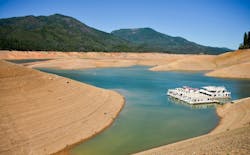Tackling Data Center Water Usage Challenges Amid Historic Droughts, Wildfires
The latest entry in a new special report series highlights how the colocation industry is tackling data center water usage amid a changing natural landscape and historic droughts and wildfires in California and beyond.
Get the full report.
The seven-year-long California drought that ended in early 2019 and the wildfires that ensued are just two recent events that have cast a spotlight on the far-reaching consequences of worsening water shortages. Those concerns have been compounded by lack of certainty about what the impact of climate change will be on water supplies.
Even without environmental change, the world is consuming water at ever-faster rates. Global population has doubled over the past 40 years but use of water has quadrupled. The Water Resources Group forecasts that global water demand may outstrip sustainable use by 40 percent as soon as 2030.
Data centers are under particular scrutiny. In the U.S. alone they are expected to consume an estimated 174 billion gallons of water in 2020. A 15-megawatt data center can use up to 360,000 gallons of water a day. Regulatory pressure is being turned up by state and local bodies that are concerned about scarcity of public resources while activist groups like Greenpeace have put a special emphasis on drawing attention to data centers’ use of both power and water. All this is happening as cooling options are narrowing due to restrictions on the use of refrigerants.
In addition to overall data center growth, demand for cooling is being driven by new applications like machine learning, cryptocurrency mining and Internet of Things devices. Artificial intelligence workloads make extensive use of power-hungry graphics processing units and AI training algorithms can require days of heavy processing.
A Complicated Equation
Data center water use has broad impacts. It affects the quality and availability of local water supplies, particularly when groundwater is involved. It invites increased regulatory scrutiny and operators may have to make expensive infrastructure investments to clean recycled water.
The role of water in power consumption is often overlooked. Few people are aware that power generation consumes more than half the water in the U.S. and Europe.
Hyperscale operators are also leading the charge toward innovative cooling strategies, pioneering the use of free-air cooling, raising operating temperatures for server inlet air and experimenting with new technologies like indirect air cooling, refrigerant economization, water to the chip, immersion cooling and rear-door chilling units. However, there is no clear solution to reducing water usage while meeting the growing cooling requirements of ever-denser compute infrastructure.
And the equation is more complicated than just the tradeoff of water versus air cooling. In fact, air cooling can actually increase overall water consumption. Air conditioning is an enormous consumer of power. A typical data center uses 35% of its power for HVAC, according to The Engineering Mindset.
The role of water in power consumption is often overlooked. Few people are aware that power generation consumes more than half the water in the U.S. and Europe. Generating a single kilowatt of electricity with coal or nuclear fuel requires about 15 gallons of water. That means that the most effective way for some data centers to reduce water usage is to cut back on power consumption. The balance comes in seeking efficient technologies that reduce or even eliminate the need for water consumption.
In the coming weeks, this Data Center Frontier Special Report series will explore tackling water usage, bracing and embracing change in the data center industry. Catch up on the first entry, as well — New Concepts of the Sustainable Data Center Arise Amid an Evolving Market. The second focused on the potential of the Smart Grid.
Get the full report, “The Rise of the Sustainable Data Center,“ for a new special report from Vertiv and Data Center Frontier explores the future of the sustainable data center and its impact on the industry.


